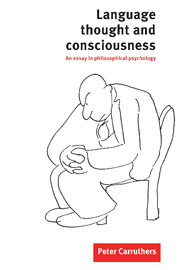Book contents
- Frontmatter
- Contents
- Preface
- Introduction
- 1 The geography of the issues
- 2 Which language do we think with?
- 3 Thought-based semantics
- 4 Holism and language
- 5 First steps towards a theory of consciousness
- 6 Second (-order) steps towards a theory of consciousness
- 7 A reflexive thinking theory of consciousness
- 8 The involvement of language in conscious thinking
- Conclusion
- References
- Index
5 - First steps towards a theory of consciousness
Published online by Cambridge University Press: 01 June 2011
- Frontmatter
- Contents
- Preface
- Introduction
- 1 The geography of the issues
- 2 Which language do we think with?
- 3 Thought-based semantics
- 4 Holism and language
- 5 First steps towards a theory of consciousness
- 6 Second (-order) steps towards a theory of consciousness
- 7 A reflexive thinking theory of consciousness
- 8 The involvement of language in conscious thinking
- Conclusion
- References
- Index
Summary
This chapter will set the scene for the remainder of the book, reviewing the desiderata for a theory of consciousness, and setting aside some false starts. After a brief retrospect, I shall begin by explaining and defending the distinction between conscious and non-conscious mental states, before criticising two theories of the nature of this distinction which I regard as being overly simple – the Cartesian conception of consciousness, and a minimalist theory due to Robert Kirk. In the final two sections I shall defend the view that consciousness is best understood in terms of higher-order thought. This idea will then be explored much more thoroughly in Chapters 6 and 7.
Retrospect: the need for a theory of consciousness
Over the last two chapters we have considered, and found wanting, Fodor's various semantic arguments for the view that the language of all thinking is Mentalese. (Further arguments were responded to directly in the latter part of Chapter 2.) The most important of these began as the argument from foreign believers, but rapidly merged into consideration of Gricean approaches to the semantics of natural language. If some version of these latter had proved acceptable, then Fodor's position would have been vindicated (at least when combined with the view that propositional attitudes are best understood as relations to sentences). But we saw that such accounts of natural-language semantics are by no means mandatory, and that they have considerable drawbacks – indeed, in the case of Grice, if not of Searle, that they are demonstrably incorrect.
- Type
- Chapter
- Information
- Language, Thought and ConsciousnessAn Essay in Philosophical Psychology, pp. 133 - 163Publisher: Cambridge University PressPrint publication year: 1996



